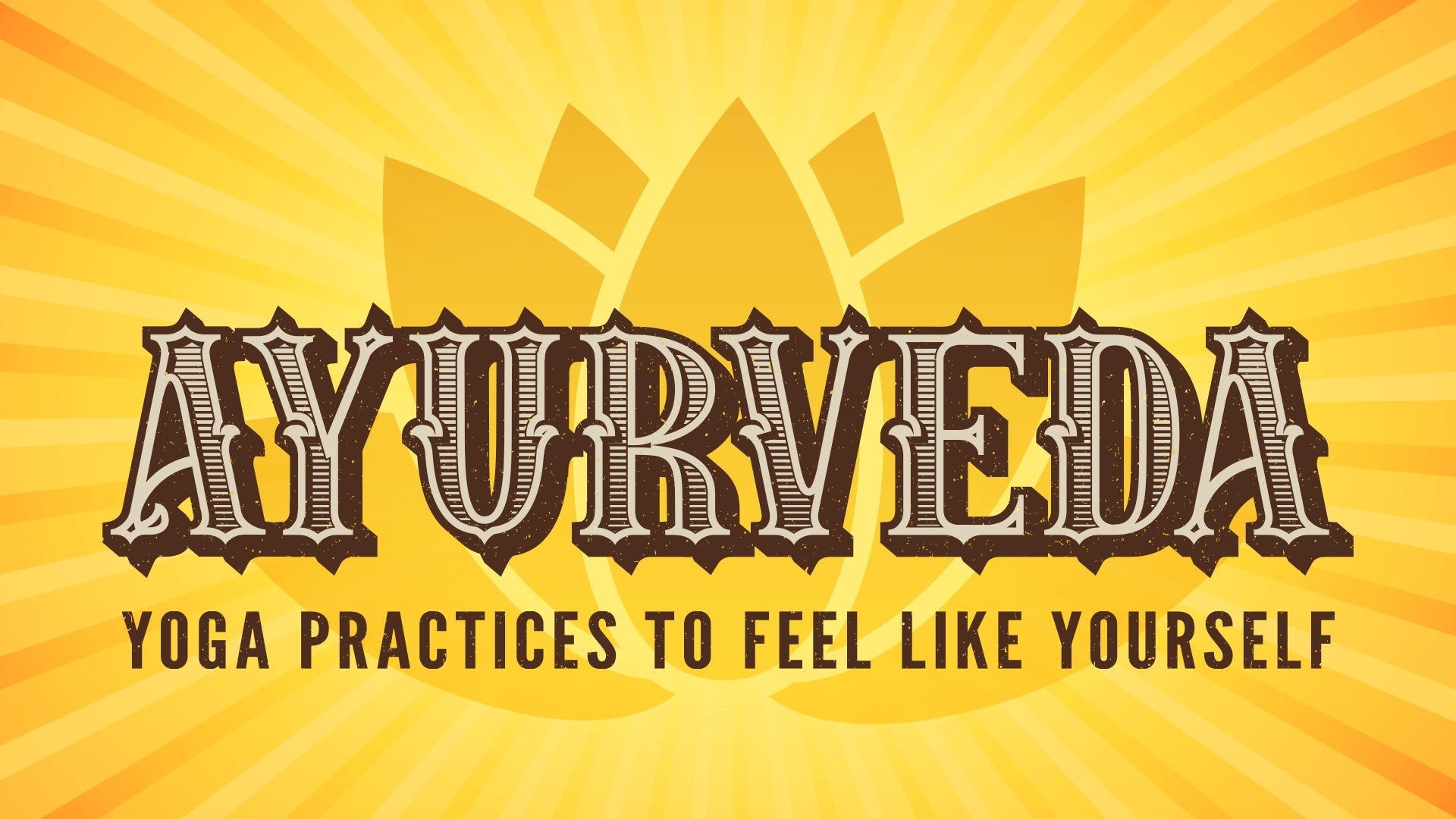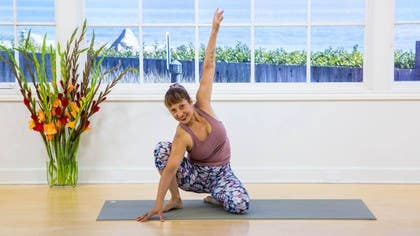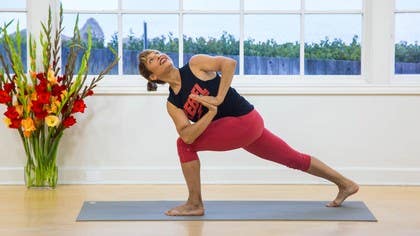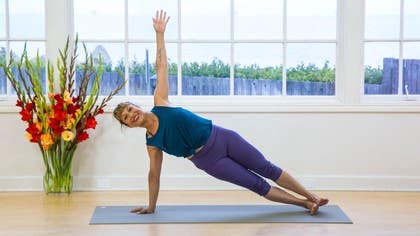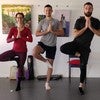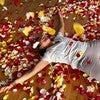Description
About This Video
Transcript
Read Full Transcript
Namaste. This will be your Apana Vayu practice. And Apana Vayu is the energy that lives in the pelvis and governs downward-moving energy. So this would be a great practice if you're feeling a little spacey, a little ungrounded. This one is very, very good for Exhasvata.
And also good for Pitta if you're feeling a little like you've gotten too much into intensity and heat because the element of Earth is very cooling. So this will be working on the lower chakras, specifically the first chakra, Muladhara, and the second chakra, Svatasthana. And we're going to start seated. So come into Sukhasana, cross-legged, and interlace all your fingers, extend your index fingers, cross your thumbs, and point your fingers downward. And this is Ksipana Mudra.
And you'll hear the word Apana in there. And so this is a mudra of pouring out and letting go and trusting the Earth to hold us up. We're going to start off with a pranayama called Bayakumbaka. And that means that the retention is on the exhalation. So you'll breathe in through your nose.
And then breathe everything out through your nose. And at the bottom of your exhalation, hold the breath out. Hold it out. See if you can just stay there with the breath held out. And then when you need to, breathe in and breathe out.
Let's try two more rounds of that together. Breathing in through the nose and breathe out. And then breathe in and breathe out normally. And then one more time, breathe in through the nose and breathe everything out. Breathing in and gently breathing out.
And that's a breath that relates to the first chakra and our ability to trust. So can we trust that the next breath will be there when we need it? It always is. You can release your mudra, give your legs a little bit of a shake out, and we're going to meet up in a squat. So you'll take the feet about as wide as your mat.
If sitting on a block in your squat is a better fit for you, then stay with that. Otherwise I'm turning the toes out slightly, letting the hips fall, and I'm coming back into my mudra and using the backs of the arms to press the thighs open, keeping a long spine and enough lift, enough mulabunda, that pelvic floor lift, so that I'm not dropping too heavy into my ankles or my knees or my hips. Take a breath there. And then gently place the hands down and lift the hips up high, lengthening out the legs. The feet can stay wide here, and I find I feel a little bit more stable with the feet wider.
Catch your elbows, give a little bend in your knees and just sway, and let your spine tumble off the top of your hips, just allowing gravity to do its work. Unravel the spine. Change the crossing of the arms, another easy sway. And if you need a sigh out through your mouth, you can do that. And then this is one of my favorite things.
Cup your ears gently with your hands and tug your head down towards your legs. Tug your head down towards your feet. And it's like a little bit of traction for the neck there. Again, just extending through the spine, hips stay pretty high, knees can stay bent if that's better for you. And then release the hands down and step back into a downward facing dog.
And once you get into your down dog, once again, concentrating on the lower chakras and the lower body, you're going to take your right foot and bisect your left heel with your big toe and your second toe and push down on the heel. And then I'm sending the hips up against that, so it's like a little weight for my left leg. And then change sides, and it's the big toe and the second toe, right around the Achilles tendon of the right foot. And push down and the hips lift up and the legs can lengthen, it just gives a little bit more weight into the right heel. And then place the left foot back down and roll out into plank pose.
Drop your knees down and take a child's pose. Take your hands underneath your shoulders and roll up to sit on your heels. And then step your right foot out like you're coming back into a half squat with the right foot. Now, if you need a block underneath you here to give you a little bit more support, you can absolutely do that. You'll take your right arm out to the right, right in front of the right chin, lift the left arm up and twist.
And the right hip stays pretty heavy here, giving you something to twist against. And then place the left hand down and you'll come into a gentle barad vajasana. So step the right foot to the inside of the left thigh, let the right knee fall open. Left leg is in like a half virosana and twist to your right. And then when you've twisted as far to the right as you can, just take the gaze back over the left shoulder.
It's actually one of my favorite poses. I just think it arranges the body in such beautiful angles. And then you can let that go and flip the left legs, bringing the sole of the left foot to the sole of the right foot, coming into bada canasana and you're not going to come forward here. You're just going to hold the ankles, use the elbows to press the thighs down and lift the spine and feel the evenness across the sitz bones. And if it doesn't feel even, rock around a little bit until you find that place where you feel very even on the sitz bones and you get that central channel, the sashumna nadi running right up through the center of the body.
One line from the pelvic floor to the crown of the head. Close the knees up, step your feet to the ground, knees are bent, hands back behind you, lifting up into an altar shape. Press the hips up, roll the shoulders back, take a breath in, a gentle breath out. And then release your hips back down. Cross your right ankle in front of your left and roll over onto your hands and your knees.
Step back, left foot, then right foot, you're in a plank pose and lower all the way down to your belly. Reach your arms out long in front of you, coming into what we call a full pranama prostration and you can take the right foot and once again, big toe, second toe, right on the left Achilles heel. It's a very traditional shape of complete surrender and then release that. Take your hands underneath your shoulders, baby cobra and press back, downward facing dog. Then once again, taking the left foot, pressing the right heel down and then change sides, getting that extra calf stretch, extra weight on the legs.
Roll out plank pose, press back, child's pose. Take your hands underneath your shoulders, roll up to sit on the heels and step your left foot into the half squat. Left arm comes in front of the left shin, lift the right arm up to twist, almost like you're thinking of energy just draining down from the right hand into the pelvis. And then bring the right hand down, coming into barred vajasana, left knee falls open, twist to the left and then look back over your right shoulder. And bring the right foot to meet the left, coming back into vajasana, finding it upright, press the thighs down, lift the chest and then close up the knees, hands back behind you, alter pose, lift the hips, push into the feet, press down to lift up and then release the hips down, cross the left ankle in front of the right, step back to plank pose and lower down, reach the arms out full pranam and this time it's the left foot that comes on the right ankle, in your surrender, in your frustration, letting the earth hold you.
And then release the feet, take the hands underneath the shoulders, cobra, pelvis stays heavy and press back, downward facing dog. And then let's go right into it, plank pose. We're going to repeat that and build on it, child's pose. Hands come under the shoulders, roll up to sit on the heels, step your right foot out into the half squat, right arm comes to the inside of the right shin, lift the left arm up and twist. Let the left hand come down, let the right knee fall open for borrowed vajasana, turning to the right, sole of the right foot inside the left thigh, look back over your left shoulder.
And then a little different this time, step your left foot right in front of your right ankle, left knee is bent, lift your left arm up, reach it forward and come into a variation of marichyasana B. So we're not doing the half lotus here, it's more like the right leg is just in sukhasana, but drop the head. And if the hands don't catch each other, you can catch your shirt, or if you've got a yoga strap nearby, you can use one of those. And then push down to roll back up, bring the soles of the feet together, come back into your bada canasana, press the thighs down, lift the chest up. Use up the legs, come back into your alter pose, lift the hips, push down to lift, breathe your way out, release the hips down, cross your right ankle in front of your left, roll over to hands and knees, step back to plank pose, lower all the way down. Reach the arms out long in front of you for your full pranam, right foot can come on top of the left ankle for your surrender here.
Your devotional moment in the middle of your practice and coming back to intention. Let that go, take the hands underneath the shoulders for your cobra and press back, downward facing dog. And lift the right leg up, bend the knee, open up your hip, still pressing down through the left heel and then stretch your right leg back up and step it outside of your right hand. Coming into your lizard shape, let the back knee drop. And then you're going to lower down onto your forearms and take your time here.
And if you need a block underneath the forearms, that's a good fit too, right? Whatever feels best for you today. But give yourself this moment just to give in to it and let gravity gently work on you. And I like to rock a little bit to the outer edge of the right foot and then a little back in towards the inner edge, just playing around in the hips. And you might even take the hands back into ksapanamudra here or drop the third eye right on top of the thumbs and then walk the hands back up, tuck the back toes under and straighten out the back leg just so you can slide the right leg into your pigeon pose.
Walk the hands back, draw the hips in and up just so that you can safely roll yourself down. And then again, push down to lift up and a big, sweet exhale to lower back down. Last time with that rolling up, pushing into the ground to rise and then coming down. And once again back onto the forearms, if you like that, thumbs can come to the third eye. You can also think of this as another full pranam and reach the arms out long and let the head drop.
And there might be a hint of that bayakumbaka, the emphasis on the exhalation, that slow exhalation, so grounding. Walk your hands back up, tuck the back toes under, down dog split, right leg up. Just give the right leg a little shake and step it back down into down dog. And then slide your way out long, plank pose, press back, child's pose. Hands underneath the shoulders, roll up to sit on the heels and step your left foot out to the left.
Left arm comes in front of the left shin, lift the right arm up, twist. And then release the right hand down, let the left knee fall open, coming into barad vajasana, twisting to the left and then looking back to the right. Let that go and step your right ankle right in front of your left ankle. Reach the right arm up, reach all the way forward as far as you can to swing the arm around the back, see if you can catch your fingertips or your shirt and fold forward. And the variation of Marichyasana B. Push into the foot to roll back up, Baddha Konasana soles the feet together, knees open, pressing the thighs down, lifting the chest up.
Use the arms to close the legs up, feet to the ground, alter pose, lift the hips. Exhale everything out. Release the hips down, cross your left ankle in front of your right, roll over to hands and knees and step back into plank, lowering down. Going back into your full pranam and you can take the left foot and bisect the right achilles this time and release that, slip the hands back underneath the shoulders, cobra, into downward facing dog. Stretch your left leg up, bend the knee, open up your hip, anchoring the right heel.
Stretch the left leg back up, step it outside of the left hand, let the back knee drop coming down into your lizard pose. Hands might come back into the ksapanamudra, third eye resting on the thumbs, rocking a little bit from side to side, it's also very soothing. And then walk your hands back up, coming into the transition, tuck the back toes under straight and out the back leg and slip the left shin across, coming into your pigeon. I walk the hands back, I draw in, lift the chest, and on the exhale folding forward. And then it's a pressing down to rise back up, chest lifts, head tips and right back down like you're being pulled back down, give in, don't resist it, one more time, lift up and exhale, come down, and then you can hang out for a breath or two, third eye on thumbs, dropping the head, listening for your breath, letting gravity work on the hips, just softening into the joints a little bit.
Walk your hands back up, stepping back, down dog split, left leg up, give the leg a little shake and downward facing dog. Last time with this, slide out plank pose, we're flowing through it, press back child's half pose, take the hands under the shoulders, roll up to sit on the heels, step your right foot into the half squat, right arm down, left arm up and twist. Right into barred vajasana, let the right knee fall open, twisting to the right, looking back to the left, release, step the left ankle in front of the right, reach the left arm up, swing it forward and back behind you, see if you can clasp your hands and let the head fall. Rolling back up, baddha kanasana, soles of the feet together, knees open, lift the spine, press the thighs down, use the arms to close up the knees, hands to the ground, lift up alter pose, breathe in, generous breath out, release the sit bones down, cross your right ankle in front of your left, roll over to hands and knees, step back to plank, lower all the way down, full pranam, reach the arms out, tucking the right big toe and second toe around the Achilles tendon of the left leg, release that, slip your hands back, cobra, and right into your down dog, lift the right leg up, bend the right knee, open up the hip, stretch the right leg back up, step it outside of your right hand, drop the back knee coming into your lizard pose, come down onto the forearms, walk the hands back up, tuck the back toes under, bring the right leg across, pigeon, just one time, lift the chest and then folding forward right away, sapana mudra, hands come into the mudra and the third eye can rest on the thumbs, and then walk your hands back up, down dog split, right leg up, this time bend the knee, open up the hip again and flip yourself inside out, come into rock star, and come back around into down dog, in your down dog walk your hands back towards your feet, and come right back into your squat, just like you started the practice, hands come back into sapana mudra, feeling that downward pull, and then you'll take a crow pose, so pressing down into the ground and making that little shelf with the arms to lift the heels up, and I'm staying pretty low to the ground here, it's almost like a squat in an arm balance, and then place the feet right back down, a moment back in your squat, and then walk the hands forward and I'm staying pretty low the whole time to come back to down dog, last time, roll it out plank pose, press back child's pose, hands under the shoulders, rolling up, step your left foot into the half squat, left arm comes in front, right arm lifts, and bring it back down, right into barad vajasana, left knee falls open, twist to the left, look back over your right shoulder, let that go, step the right foot to the ground, right ankle in front of the left, reach the right arm up, swing it out in front of you, coming into your marici asana b variation, and then come on back up, soles of the feet together, knees open, bodhicanasana, lift the chest, bring the legs in, hands back behind you, you know where this is going, lift the hips up, push the arms down, push the feet down, release the sit bones back down, cross the left ankle in front of the right, step back into your plank pose and lower all the way down, it's like we keep returning back down to the ground, arms stretch out for a full pranam, left big toe and second toe right on top of the right achilles, take your hands back underneath your shoulders for a cobra, and press back downward facing dog, lift the left leg up, bend the left knee, open up the hip, stretch the left leg back up, step it outside of your left hand, drop the back knee, come on down to the forearms, except panamudra, third eye on the thumbs, releasing the head, and then walk the hands back up, tuck the back toes under and slide the left leg across for the pigeon, lift the chest, and then just fold forward, come on back down, always returning back down, the comfort and the stability of upon a vayu, walk the hands back underneath you, down dog, split left leg up, bend the knee, open the hip, flip into rockstar, come back around downward facing dog, walk the hands back towards the feet, separate the feet wider if need be, come into your squat, except panamudra, take a breath, center yourself, and then last time, cropos, bringing the feet together, stretching the weight all the way forward to gather in the feet, and release back down. And then you can come back into your easy seat, your sweet seat, sukhasana, and you can take your hands back into the except panamudra.
And we're going to close the practice with three more rounds of Vaya Kumbhaka, so that's that retention on the exhalation, breathe in through the nose, breathe everything out and hold the breath out. Trust it, the next breath is there for you, breathe in, gentle breathe out. And then inhale, exhale everything out, get empty, and then breathe in, and breathe out. Last time, breathe in, breathe everything out, totally empty, trust it, hold it out, and breathe in, and breathe out. And then one of the most grounding poses of all, come right into your shavasana, lay yourself down and just allow the weight of the limbs to completely release and let the muscles go soft.
Just let yourself be there. All right, now we're going to close the practice with three more rounds of Vaya Kumbhaka, and we're going to close the practice with three more rounds of Vaya Kumbhaka, and we're going to let your next breath come in a little bit deeper, and once again just let it exhale away, still feeling the weight of the body on the ground, you can make some little movements with the fingers and the toes, and then walk the soles of the feet in, feel them on the ground, roll onto your right side, and use the arms to come on up to sit, and hopefully you're feeling a bit more grounded, a little more connected to the earth, a little more in touch with that Upana Vayu, that downward moving energy, namaste.
Ayurveda: Practices to Feel Like Yourself: The Vayus
Comments
You need to be a subscriber to post a comment.
Please Log In or Create an Account to start your free trial.
